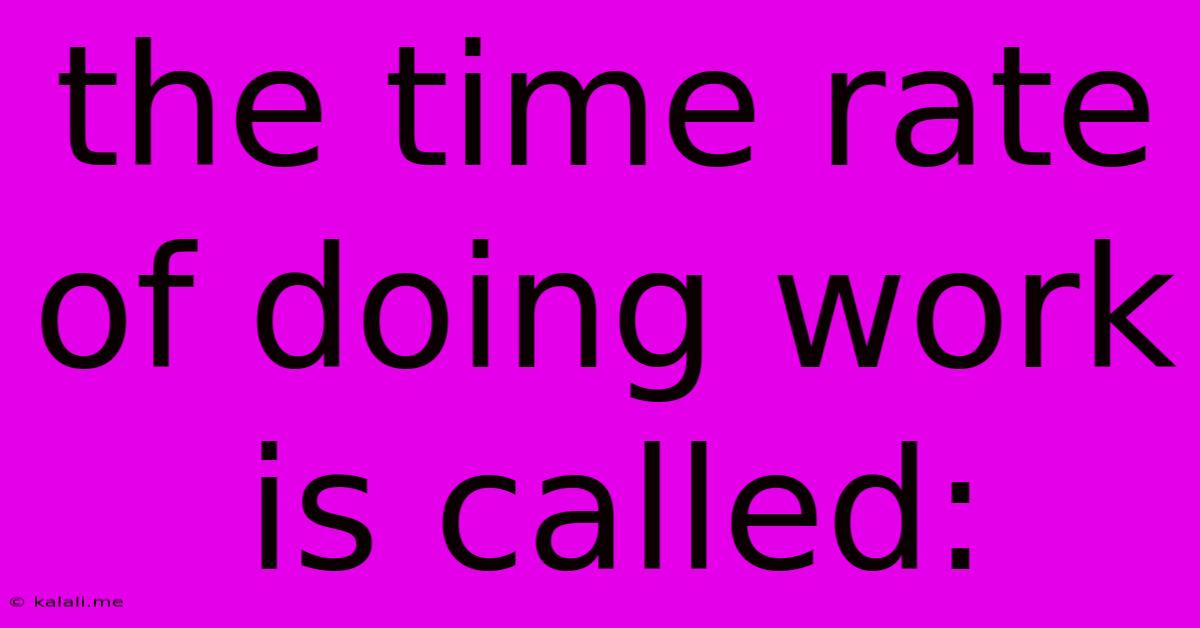The Time Rate Of Doing Work Is Called
Kalali
Jun 12, 2025 · 3 min read

Table of Contents
The Time Rate of Doing Work is Called: Power Explained
The time rate of doing work is called power. Understanding power is crucial in physics, engineering, and everyday life. This article will delve into the definition of power, explore its units of measurement, and discuss various applications and examples. We'll also touch upon the relationship between power, work, and energy.
Power represents how quickly work is done or energy is transferred. It's not simply about the amount of work accomplished, but the speed at which it's accomplished. A powerful engine, for instance, can perform a large amount of work in a short amount of time, whereas a less powerful engine might take much longer to do the same job.
Understanding the Formula for Power
The fundamental formula for calculating power is:
Power (P) = Work (W) / Time (t)
Where:
- Power (P) is measured in Watts (W)
- Work (W) is measured in Joules (J)
- Time (t) is measured in seconds (s)
This equation tells us that power is directly proportional to work and inversely proportional to time. More work done in the same amount of time means higher power; the same amount of work done in less time also means higher power.
Units of Power: Watts and Horsepower
The standard unit of power in the International System of Units (SI) is the Watt (W). One Watt is equal to one Joule per second (1 J/s). However, you might also encounter another unit, especially in older contexts: horsepower (hp). One horsepower is approximately equal to 746 Watts. Horsepower is often used to describe the power of engines, especially in vehicles and machinery.
Different Types of Power
While the basic concept remains the same, the application of power can vary across different fields. We encounter various types of power, including:
- Mechanical Power: This refers to the rate at which mechanical work is done, often associated with machines and engines. Examples include the power of a car engine or a crane lifting a heavy object.
- Electrical Power: This is the rate at which electrical energy is transferred or converted. It's a common term used in the context of electricity consumption and generation. Kilowatts (kW) and megawatts (MW) are often used to describe electrical power.
- Hydraulic Power: This involves the use of fluids (liquids or gases) to transmit and control power. Hydraulic systems are used in various applications, including heavy machinery and braking systems.
Real-World Examples of Power
Understanding power is essential in various everyday scenarios:
- Comparing light bulbs: A 100-watt bulb consumes energy and produces light at a faster rate than a 60-watt bulb.
- Evaluating car engines: A car with a higher horsepower engine will accelerate faster and have greater pulling power.
- Assessing human physical performance: Athletes train to increase their power output, allowing them to run faster, jump higher, or lift heavier weights.
Power, Work, and Energy: The Interconnected Trio
Power, work, and energy are intrinsically linked concepts. Work is the transfer of energy, while energy is the capacity to do work. Power is the rate at which this energy transfer (work) occurs. They are all fundamental aspects of physics and are essential to understanding how things move and function.
In conclusion, the time rate of doing work is indeed power. Understanding this concept, along with its formula and units, is vital for comprehending various physical phenomena and technological advancements. From the efficiency of household appliances to the performance of powerful engines, power plays a significant role in our daily lives.
Latest Posts
Latest Posts
-
City College Of San Francisco Acceptance Rate
Jun 13, 2025
-
Average Gpa For Washington State University
Jun 13, 2025
-
How Many Chambers In A Frog Heart
Jun 13, 2025
-
What Is The Integral Of Xlnx
Jun 13, 2025
-
Drastic Times Call For Drastic Measures
Jun 13, 2025
Related Post
Thank you for visiting our website which covers about The Time Rate Of Doing Work Is Called . We hope the information provided has been useful to you. Feel free to contact us if you have any questions or need further assistance. See you next time and don't miss to bookmark.